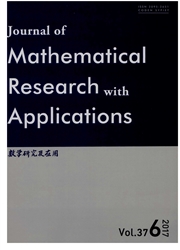

 中文摘要:
中文摘要:
In this paper, we give some characterizations of almost completely regular spaces and c-semistratifiable spaces(CSS) by semi-continuous functions. We mainly show that:(1)Let X be a space. Then the following statements are equivalent:(i) X is almost completely regular.(ii) Every two disjoint subsets of X, one of which is compact and the other is regular closed, are completely separated.(iii) If g, h : X → I, g is compact-like, h is normal lower semicontinuous, and g ≤ h, then there exists a continuous function f : X → I such that g ≤ f ≤ h;and(2) Let X be a space. Then the following statements are equivalent:(a) X is CSS;(b) There is an operator U assigning to a decreasing sequence of compact sets(Fj)j∈N,a decreasing sequence of open sets(U(n,(Fj)))n∈N such that(b1) Fn■U(n,(Fj)) for each n ∈ N;(b2)∩n∈NU(n,(Fj)) =∩n∈NFn;(b3) Given two decreasing sequences of compact sets(Fj)j∈N and(Ej)j∈N such that Fn■Enfor each n ∈ N, then U(n,(Fj))■U(n,(Ej)) for each n ∈ N;(c) There is an operator Φ : LCL(X, I) → USC(X, I) such that, for any h ∈ LCL(X, I),0 Φ(h) h, and 0 < Φ(h)(x) < h(x) whenever h(x) > 0.
 英文摘要:
英文摘要:
In this paper, we give some characterizations of almost completely regular spaces and c-semistratifiable spaces(CSS) by semi-continuous functions. We mainly show that:(1)Let X be a space. Then the following statements are equivalent:(i) X is almost completely regular.(ii) Every two disjoint subsets of X, one of which is compact and the other is regular closed, are completely separated.(iii) If g, h : X → I, g is compact-like, h is normal lower semicontinuous, and g ≤ h, then there exists a continuous function f : X → I such that g ≤ f ≤ h;and(2) Let X be a space. Then the following statements are equivalent:(a) X is CSS;(b) There is an operator U assigning to a decreasing sequence of compact sets(Fj)j∈N,a decreasing sequence of open sets(U(n,(Fj)))n∈N such that(b1) Fn■U(n,(Fj)) for each n ∈ N;(b2)∩n∈NU(n,(Fj)) =∩n∈NFn;(b3) Given two decreasing sequences of compact sets(Fj)j∈N and(Ej)j∈N such that Fn■Enfor each n ∈ N, then U(n,(Fj))■U(n,(Ej)) for each n ∈ N;(c) There is an operator Φ : LCL(X, I) → USC(X, I) such that, for any h ∈ LCL(X, I),0 Φ(h) h, and 0 〈 Φ(h)(x) 〈 h(x) whenever h(x) 〉 0.
 同期刊论文项目
同期刊论文项目
 同项目期刊论文
同项目期刊论文
 期刊信息
期刊信息
